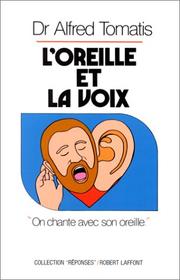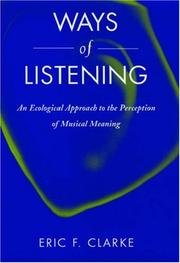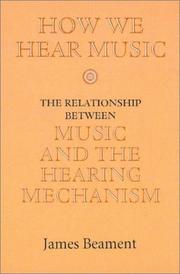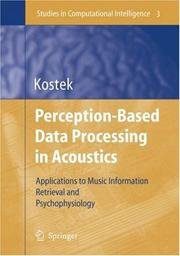| Listing 1 - 8 of 8 |
Sort by
|

ISBN: 0262071819 9780585133204 0262274310 0585133204 9780585133201 9780262274319 9780262071819 Year: 1999 Publisher: Cambridge, Mass. MIT
Abstract | Keywords | Export | Availability | Bookmark
 Loading...
Loading...Choose an application
- Reference Manager
- EndNote
- RefWorks (Direct export to RefWorks)
"This volume presents the most up-to-date collection of neural network models of music and creativity gathered together in one place. Chapters by leaders in the field cover new connectionist models of pitch perception, tonality, musical streaming, sequential and hierarchical melodic structure, composition, harmonization, rhythmic analysis, sound generation, and creative evolution."--Jacket.
Cognitive psychology --- Music --- Affective and dynamic functions --- Cognitie --- Cognition --- Connectionism --- Connectionisme --- Connectionnisme --- Connexionism --- Music -- Perception --- Musical perception --- Musique -- Perception --- Muziek -- Perceptie --- Muzikale perceptie --- Muzikale waarneming --- Oreille absolue --- Oreille musicale --- Perception de la musique --- Perception musicale --- Cognition. --- Connectionism. --- Musical perception. --- Music Philosophy --- Music, Dance, Drama & Film --- Psychology --- Auditory perception --- Psychological aspects

ISSN: 03973972 ISBN: 2221052412 9782221052419 9782221107140 2221094816 2221107144 Year: 1987 Publisher: Paris Laffont
Abstract | Keywords | Export | Availability | Bookmark
 Loading...
Loading...Choose an application
- Reference Manager
- EndNote
- RefWorks (Direct export to RefWorks)
Connu mondialement pour ses travaux sur l'audition et la phonation, le Dr Alfred Tomatis introduit le lecteur dans un domaine qui le passionne depuis sa tendre enfance : celui du chant. Spécialisé en phoniatrie et plus particulièrement en neurophysiologie auditive, l'auteur présente à la fois sous le couvert de l'anecdote et sur un plan purement scientifique, ses conceptions sur l'oreille humaine en tant que capteur de contrôle de la voix et du langage. "On chante avec son oreille", n'hésite-t-il pas à proclamer sous forme de boutade mais également avec le souci constant d'apporter les preuves irréfutables que sa longue expérience de chercheur et de clinicien lui ont permis de mettre en évidence. Le rôle de l'oreille, en effet se manifeste de façon dominante dans la justesse et la force de l'émission vocale. Le Dr Tomatis nous explique ici tous les mécanismes de l'audition, l'importance des résonateurs, le rôle des os de la face dans le travail du chant, etc. Ce livre devrait passionner tous les chanteurs professionnels ou amateurs ainsi que ceux qui ont des problèmes vocaux ou souhaitent connaître le secret des "grandes voix" d'hier et d'aujourd'hui. (4e de couverture)
Voice --- Singing --- Ear --- physiology --- Physiological aspects --- 415 --- Theorie van de zang: stemvorming --- Psychological aspects --- 639 --- Vocale didactiek - Stemtechniek --- Singing - physiology --- Ear - physiology --- Singing - Physiological aspects --- Voice - Physiological aspects --- Zangtechniek --- Gehoortraining --- 20e eeuw --- Audiophonologie --- Voix --- Oreille --- Chant --- Voix. --- Oreille. --- Physiologie --- Physiologie. --- Technique --- Physiological aspects.

ISBN: 0195151941 0199870403 1602569452 9786610482429 1423745884 1280482427 0195348540 0199773904 9780199773909 9780195151947 Year: 2005 Publisher: Oxford Oxford University Press
Abstract | Keywords | Export | Availability | Bookmark
 Loading...
Loading...Choose an application
- Reference Manager
- EndNote
- RefWorks (Direct export to RefWorks)
In recent years, many psychologists and cognitive scientists have published their views on the psychology of music. Unfortunately, this scientific literature has remained inaccessible to musicologists and musicians, and has neglected their insights on the subject. In Ways of Listening, musicologist Eric Clarke explores musical meaning, music's critical function in human lives, and the relationship between listening and musical material. Clarke outlines an "ecological approach" to understanding the perception of music. The way we hear and understand music is not simply a function of our brain structure or of the musical "codes" given to us by culture, Clarke argues. Instead, cognitive, psychoacoustical, and semiotic issues must be considered within the physical and social contexts of listening. In essence, Clarke adapts John Gibson's influential ecological theory of perception to the complex process of perceiving music. In addition to making a theoretical argument, the author offers a number of case studies to illustrate his concept. For example, he analyzes the experience of listening to Jimi Hendrix's performance of the Star Spangled Banner at Woodstock in 1969. Clarke examines how Hendrix's choice of instrument and venue, use of distortion, and the political climate in which he performed all had an impact on his audience's perception of the anthem. A complex convergence of broad cultural contexts and specific musical features - the entire "ecology" of the listening experience - is responsible for this performance's impact. Including both the best psychological research and careful musicological scholarship, Clarke's book offers the most complex and insightful perspective on musical meaning to date. It will be of interest to musicologists, musicians, psychologists, and scholars of aesthetics.
Music -- Perception --- Musical perception --- Musicologie --- Musicology --- Musique -- Perception --- Muziek -- Perceptie --- Muzikale perceptie --- Muzikale waarneming --- Oreille absolue --- Oreille musicale --- Perception de la musique --- Perception musicale --- 571 --- Muziekpsychologie --- Music --- History and criticism --- Nature (Aesthetics) --- Art and nature --- Nature and art --- Musicology. --- Perception. --- Perception --- Aesthetics --- Criticism --- Auditory perception --- Psychological aspects

ISBN: 0851159400 0851158137 9786611949037 1281949035 1846154413 9780851159409 Year: 2001 Publisher: Rochester The Boydell Press
Abstract | Keywords | Export | Availability | Bookmark
 Loading...
Loading...Choose an application
- Reference Manager
- EndNote
- RefWorks (Direct export to RefWorks)
Choice Outstanding Academic Title (2002)Our hearing system chose the sounds for music. During the past fifty years there have been spectacular advances in our knowledge of how that system works and it seems possible that it might provide explanations for a range of musical phenomena. This book begins by discussing the early evolution of simple 'western' tonal music; what exactly were the characteristics of the intervals and scales which hearing selected. It then considers problems such as what hearing has selected as instrumental tone, and why we have such a peculiar assessment of loudness; why is that independent of pitch, and why is hearing so sensitive to time? Does the mechanism of hearing determine our pitch discrimination, which differs so much across our hearing range? Amongst other things, this discussion leads to the conclusion that the harmonics of musical sounds, which are the basis of so much theory about music, did not and cannot play the role which has been so widely attributed to them ever since the work of Helmholtz in 1870. There follows a simplified account of the hearing mechanism: how musical sound is coded by the ear, the nature of the processing stations through which the information passes before it creates sensation in the cortex, and the extent to which it provides answers to the questions which have been raised. This produces a rather different view of the basis of some fundamental features of music from those which are commonly held. It also leads to the conclusion that music started with primitive instruments rather than with the human voice. Finally, the biological reasons for the hearing mechanism behaving as it does are explained, and thus the reasons for the sensations of music being experienced in the way they are. No scientific knowledge is assumed; any simple physical acoustics required is explained, and there are no mathematical equations. The late Professor Sir JAMES BEAMENT was a distinguished scientist and musician, who taught and examined music students at Cambridge University.
Acoustics --- Acoustique --- Akoestiek --- Audition (Physiology) --- Gehoor --- Hearing --- Music -- Perception --- Musical perception --- Musique -- Perception --- Muziek -- Perceptie --- Muzikale perceptie --- Muzikale waarneming --- Oreille absolue --- Oreille musicale --- Ouïe --- Perception de la musique --- Perception musicale --- Physiological acoustics --- Music --- Acoustics and physics --- Music - Acoustics and physics. --- Music - Acoustics and physics --- Music - Physiological aspects --- Musical perception. --- Hearing. --- Acoustics and physics. --- Ouïe --- Musique --- Acoustique et physique --- 515 --- 840 --- Musical acoustics --- Physics --- Sound --- Monochord --- Auditory perception --- Bioacoustics --- Senses and sensation --- Audiology --- Auditory pathways --- Deafness --- Ear --- Listening --- Akoestika --- Muziekgeschiedenis: essays (histor. onderwerpen, literaire analyses) --- Psychological aspects --- 78.82 --- Acoustics. --- Hearing Mechanism. --- Music. --- Sound Direction. --- Western Music.
Periodical
ISSN: 18099777 18094864
Abstract | Keywords | Export | Availability | Bookmark
 Loading...
Loading...Choose an application
- Reference Manager
- EndNote
- RefWorks (Direct export to RefWorks)
Otorhinolaryngologic Diseases. --- Otolaryngology. --- Otolaryngology --- Throat --- Nose --- Ear --- Oto-rhino-laryngologie --- Gorge --- Nez --- Oreille --- Periodicals. --- Diseases --- Périodiques --- Maladies --- Diseases. --- medicine --- otorhinolaryngology --- Sore throat --- Ear, nose, and throat diseases --- ENT diseases --- Otorhinolaryngology --- Laryngology --- Otology --- ENT Diseases --- Otolaryngological Diseases --- Otorhinolaryngologic Disease --- Otorhinolaryngological Disease --- Otolaryngologic Diseases --- Disease, ENT --- Disease, Otolaryngologic --- Disease, Otolaryngological --- Disease, Otorhinolaryngologic --- Disease, Otorhinolaryngological --- Diseases, ENT --- Diseases, Otolaryngologic --- Diseases, Otolaryngological --- Diseases, Otorhinolaryngologic --- Diseases, Otorhinolaryngological --- ENT Disease --- Otolaryngologic Disease --- Otolaryngological Disease --- Otorhinolaryngological Diseases --- Auditory system --- Rhinology --- Medicine --- Audiology --- Otologic Surgical Procedures --- Otorhinolaryngologic Surgical Procedures --- Nasal Surgical Procedures --- Head --- Sense organs --- Hearing --- Face --- Smell --- Neck --- otorhinolaryngology --- head surgery --- neck surgery --- phoniatry --- audiology
Book

Year: 2020 Publisher: Basel, Switzerland MDPI - Multidisciplinary Digital Publishing Institute
Abstract | Keywords | Export | Availability | Bookmark
 Loading...
Loading...Choose an application
- Reference Manager
- EndNote
- RefWorks (Direct export to RefWorks)
River discharge is a fundamental hydrologic quantity that summarizes how a watershed transforms the input of precipitation into output as channelized streamflow. Accurate discharge measurements are critical for a range of applications including water supply, navigation, recreation, management of in-stream habitat, and the prediction and monitoring of floods and droughts. However, the traditional stream gage networks that provide such data are sparse and declining. Remote sensing represents an appealing alternative for obtaining streamflow information. Potential advantages include greater efficiency, expanded coverage, increased measurement frequency, lower cost and reduced risk to field personnel. In addition, remote sensing provides opportunities to examine long river segments with continuous coverage and high spatial resolution. To realize these benefits, research must focus on the remote measurement of flow velocity, channel geometry and their product: river discharge. This Special Issue fostered the development of novel methods for retrieving discharge and its components, and thus stimulated progress toward an operational capacity for streamflow monitoring. The papers herein address all aspects of the remote measurement of streamflow—estimation of flow velocity, bathymetry (water depth), and discharge—from various types of remotely sensed data acquired from a range of platforms: manned and unmanned aircraft, satellites, and ground-based non-contact sensors.
estuary --- morphology --- rapid assessment --- bathymetry --- flow velocity --- salinity --- tool --- remotely-sensed imagery --- small unmanned aerial system (sUAS) --- river flow --- thermal infrared imagery --- particle image velocimetry --- lidar bathymetry --- fluvial --- geomorphology --- change detection --- remotely piloted aircraft system --- refraction correction --- structure-from-motion photogrammetry --- water surface elevation --- topographic error --- machine learning --- UAV LiDAR --- airborne laser bathymetry --- full waveform processing --- performance assessment --- high resolution hydro-mapping --- remote sensing --- rivers --- discharge --- hydrology --- modelling --- ungauged basins --- Alaska --- river --- PIV --- large-scale particle image velocimetry --- LSPIV --- surface velocity --- river discharge --- Doppler radar --- pulsed radar --- probability concept --- water temperature --- salmonids --- Pend Oreille River --- thermal infrared (TIR) --- acoustic Doppler current profiler (ADCP) --- channel bathymetry --- cold-water refuge --- dam --- flooding --- high-water marks (HWMs) --- small unmanned aircraft systems (sUAS) --- drone --- photogrammetry --- hydraulic modeling --- aerial photography --- surveying --- inundation --- Landsat --- streamflow --- flow frequency --- satellite revisit time --- flow regime
Periodical
ISSN: 00016489 16512251 16512553 Year: 1918 Publisher: Stockholm
Abstract | Keywords | Export | Availability | Bookmark
 Loading...
Loading...Choose an application
- Reference Manager
- EndNote
- RefWorks (Direct export to RefWorks)
" ... presents original articles of basic research interest regarding clinical questions at hand, as well as clinical studies in the field of otorhinolaryngology and related subdisciplines."
otorinolaryngologie --- Otorhinolaryngology --- Otolaryngology --- Ear --- Throat --- Oto-rhino-laryngologie --- Oreille --- Gorge --- periodicals. --- Diseases --- Periodicals --- Periodicals. --- Maladies --- Périodiques --- Otolaryngology. --- Otorhinolaryngologic Diseases. --- Keel- neus- en oorheelkunde. --- Laryngology --- Otology --- Audiology --- Otologic Surgical Procedures --- Otorhinolaryngologic Surgical Procedures --- Nasal Surgical Procedures --- Health Sciences --- Clinical Medicine --- Ear, Nose & Throat --- Medical Education, Training & Research --- Oncology --- Surgery --- Diseases. --- Health Sciences. --- Surgery. --- Périodiques --- EBSCOASP-E EPUB-ALPHA-A EPUB-PER-FT MDOTOLAR --- ENT Diseases --- Otolaryngological Diseases --- Otorhinolaryngologic Disease --- Otorhinolaryngological Disease --- Otolaryngologic Diseases --- Disease, ENT --- Disease, Otolaryngologic --- Disease, Otolaryngological --- Disease, Otorhinolaryngologic --- Disease, Otorhinolaryngological --- Diseases, ENT --- Diseases, Otolaryngologic --- Diseases, Otolaryngological --- Diseases, Otorhinolaryngologic --- Diseases, Otorhinolaryngological --- ENT Disease --- Otolaryngologic Disease --- Otolaryngological Disease --- Otorhinolaryngological Diseases --- Sore throat --- Ear, nose, and throat diseases --- ENT diseases --- Auditory system --- Medicine --- Neck --- Head --- Sense organs --- Hearing --- Otorhinolaryngologie --- Public health --- Social medicine --- Social Medicine. --- Public Health. --- Santé publique --- Médecine sociale --- Public health. --- Social medicine. --- Sociale gezondheidszorg. --- Sociale geneeskunde. --- Finland. --- Iceland. --- Scandinavia. --- Medical care --- Medical sociology --- Medicine, Social --- Public welfare --- Sociology --- Medical ethics --- Medical sociologists --- Community health --- Health services --- Hygiene, Public --- Hygiene, Social --- Public health services --- Public hygiene --- Social hygiene --- Health --- Human services --- Biosecurity --- Health literacy --- Medicine, Preventive --- National health services --- Sanitation --- Community Health --- Environment, Preventive Medicine & Public Health --- Environment, Preventive Medicine and Public Health --- Health, Community --- Health, Public --- Preventive Medicine --- Education, Public Health Professional --- Public Health --- Social aspects --- Fennoscandia --- Norden --- Nordic countries --- Aland Islands --- Åland Islands --- Nordic Countries --- Scandinavia --- Otorhinolaryngologic Diseases --- Oto-rhino-laryngologie. --- Maladies oto-rhino-laryngologiques. --- Social Medicine --- Médecine sociale. --- Santé publique. --- public health. --- Finland --- Iceland --- Scandinavian and Nordic Countries --- Otorinolaryngologi --- Otorrinolaringologia --- Otorrinolaringologia.

ISBN: 9783540257295 3540257292 3540324011 Year: 2005 Volume: 3 Publisher: Berlin, Heidelberg : Springer Berlin Heidelberg : Imprint: Springer,
Abstract | Keywords | Export | Availability | Bookmark
 Loading...
Loading...Choose an application
- Reference Manager
- EndNote
- RefWorks (Direct export to RefWorks)
The objective of the monograph is to provide novel insights into cognitive mechanisms underlying processing of sound and music in different environments. A solid understanding of these mechanisms is vital for numerous technological applications such as for example information retrieval from distributed musical databases or building expert systems. In order to investigate the cognitive mechanisms underlying music perception fundamentals of hearing psychophysiology and principles of music perception are presented. In addition, some computational intelligence methods are reviewed, such as rough sets, fuzzy logic, artificial neural networks, decision trees and genetic algorithms. The applications of hybrid decision systems to problem solving in music and acoustics are exemplified in this book and discussed on the basis of obtained experimental results.
Music --- Automatic Data Processing --- Acoustic Stimulation --- Auditory Perception --- Information storage and retrieval --- Auditory perception --- Ear --- Musique --- Systèmes d'information --- Perception auditive --- Oreille --- methods --- physiology --- Acoustics and physics --- Data processing --- Psychophysiology --- Acoustique et physique --- Informatique --- Psychophysiologie --- Methods --- Physiology --- Investigative Techniques --- Perception --- Humanities --- Biological Science Disciplines --- Computing Methodologies --- Therapeutics --- Information Science --- Analytical, Diagnostic and Therapeutic Techniques and Equipment --- Natural Science Disciplines --- Mental Processes --- Psychological Phenomena and Processes --- Disciplines and Occupations --- Psychiatry and Psychology --- Music Philosophy --- Civil Engineering --- Applied Mathematics --- Civil & Environmental Engineering --- Engineering & Applied Sciences --- Music, Dance, Drama & Film --- Psychologic Processes and Principles --- Human Information Processing --- Information Processing, Human --- Natural Sciences --- Physical Sciences --- Discipline, Natural Science --- Disciplines, Natural Science --- Natural Science --- Natural Science Discipline --- Physical Science --- Science, Natural --- Science, Physical --- Sciences, Natural --- Sciences, Physical --- Information Sciences --- Science, Information --- Sciences, Information --- Therapy --- Treatment --- Therapeutic --- Therapies --- Treatments --- Disease --- High Performance Computing --- Methodologies, Computing --- Computing Methodology --- Computing, High Performance --- Methodology, Computing --- Performance Computing, High --- Biologic Sciences --- Biological Science --- Science, Biological --- Sciences, Biological --- Biological Sciences --- Life Sciences --- Biologic Science --- Biological Science Discipline --- Discipline, Biological Science --- Disciplines, Biological Science --- Life Science --- Science Discipline, Biological --- Science Disciplines, Biological --- Science, Biologic --- Science, Life --- Sciences, Biologic --- Sciences, Life --- Perceptions --- Investigative Technics --- Investigative Technic --- Investigative Technique --- Technic, Investigative --- Technics, Investigative --- Technique, Investigative --- Techniques, Investigative --- Auditory Perceptions --- Perception, Auditory --- Perceptions, Auditory --- Information Processing --- Bar Codes --- Computer Data Processing --- Data Processing, Automatic --- Electronic Data Processing --- Information Processing, Automatic --- Optical Readers --- Automatic Information Processing --- Bar Code --- Code, Bar --- Codes, Bar --- Data Processing, Computer --- Data Processing, Electronic --- Optical Reader --- Processing, Automatic Data --- Processing, Automatic Information --- Processing, Computer Data --- Processing, Electronic Data --- Processing, Information --- Reader, Optical --- Readers, Optical --- Auditory Stimulation --- Stimulation, Acoustic --- Stimulation, Auditory --- Methodological Studies --- Methodological Study --- Procedures --- Studies, Methodological --- Study, Methodological --- Method --- Procedure --- Classical Music --- Hip Hop Music --- Jazz Music --- Rap Music --- Rock and Roll Music --- Songs --- Vocal Melody --- Hop Music, Hip --- Melodies, Vocal --- Melody, Vocal --- Music, Classical --- Music, Hip Hop --- Music, Jazz --- Music, Rap --- Song --- Vocal Melodies --- Auditory system --- Sound perception --- Art music --- Art music, Western --- Classical music --- Musical compositions --- Musical works --- Serious music --- Western art music --- Western music (Western countries) --- Musical acoustics --- therapy --- Physics --- Computer science. --- Computers. --- Artificial intelligence. --- Psycholinguistics. --- Acoustics. --- Applied mathematics. --- Engineering mathematics. --- Cognitive psychology. --- Computer Science. --- Theory of Computation. --- Appl.Mathematics/Computational Methods of Engineering. --- Artificial Intelligence (incl. Robotics). --- Cognitive Psychology. --- Psychology, Cognitive --- Cognitive science --- Psychology --- Engineering --- Engineering analysis --- Mathematical analysis --- Language, Psychology of --- Language and languages --- Psychology of language --- Speech --- Linguistics --- Thought and thinking --- AI (Artificial intelligence) --- Artificial thinking --- Electronic brains --- Intellectronics --- Intelligence, Artificial --- Intelligent machines --- Machine intelligence --- Thinking, Artificial --- Bionics --- Digital computer simulation --- Electronic data processing --- Logic machines --- Machine theory --- Self-organizing systems --- Simulation methods --- Fifth generation computers --- Neural computers --- Automatic computers --- Automatic data processors --- Computer hardware --- Computing machines (Computers) --- Electronic calculating-machines --- Electronic computers --- Hardware, Computer --- Computer systems --- Cybernetics --- Calculators --- Cyberspace --- Informatics --- Science --- Mathematics --- Psychological aspects --- Information theory. --- Consciousness. --- Mathematical and Computational Engineering. --- Artificial Intelligence. --- Apperception --- Mind and body --- Philosophy --- Spirit --- Self --- Communication theory --- Communication
| Listing 1 - 8 of 8 |
Sort by
|

 Search
Search Feedback
Feedback About UniCat
About UniCat  Help
Help News
News